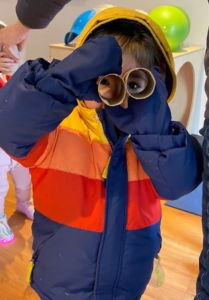Sign Up for a Virtual Open House!
Sign Up for a Virtual Open House!
January 21, 2022
“Even when helping and serving the children, she(the teacher) must not cease to observe them, because the birth of concentration in a child is as delicate a phenomenon as the bursting of a bud into bloom”
– Maria Montessori, The Absorbent Mind.

As adults, we are often inclined to share our experiences and knowledge with our children as they explore the world and navigate relationships. With their natural curiosity, innate joy and ability to be fully present in the moment, we can be tempted to insert ourselves into every area of their development. We do this from a place of love; believing that if we can show them what to do, tell them what to say and how to behave, we can minimize frustration, prevent emotional hurt or even give them an academic jumpstart. We cannot. What we can do, however, is observe. When looking up the definition of the word this was offered, Observe: “notice or perceive (something) and register it as significant.”
For Dr Maria Montessori observation was the cornerstone of her teaching. We cannot follow the child if we are in fact the ones doing the leading. When we observe, our goal is to see children without an agenda, withholding our judgement or need for correction. While observing may feel like we are under-participating in our child’s life, it actually offers deep insight, allowing us to then participate with purposeful and supportive guidance. Observing children on a regular basis helps us better understand the universal patterns of child development and the learning styles unique to each child, more specifically our own child.
Observation takes practice, and like any healthy practice we can start with short intervals. When our child is eating dinner, focused on getting food on the spoon, and the spoon to their mouth, resist the urge to offer assistance or to direct with words. Give them the space to figure it out. When your child is digging in the sand, don’t immediately ask if they want to build a castle or dig a hole and fill it with water. Just experience the joy of watching your child experience the joy of digging in the sand. Don’t confuse observing with disengagement. Of course we talk with our children at dinner and the beach. In our moments of quiet observation, we are giving our children time; time to solve a problem, finish a thought, or process the cause and effect of their efforts. We are showing them respect; letting them know that we have confidence in their ability to find solutions. We are in the moment to learn from them.
We know that children have an internal, unconscious drive to explore and learn. They do not need us cheering for or narrating their daily activities. Mindful observation of behavior can reveal a child’s temperament and approach to learning, leading us to offer supportive environments. It is during our observations that children reveal their deeper selves, and what begins as seemingly random or even chaotic behavior begins to make sense. Behavioral patterns that reveal emotional turbulence can be exposed, as young children cannot always put words to feelings. Emotions and behaviors are tightly linked, and behavior is often loud, if not clear, at first glance.
Our initial definition stated that when we observe, “we are perceiving something that is significant.” This cuts to the heart of child development. Every movement, every pause, every facial expression, every withdrawal, every advance and every utterance made by a child in a moment of concentration is significant. We must do all we can to protect this process.
Dawn Gunn, toddler classroom teacher